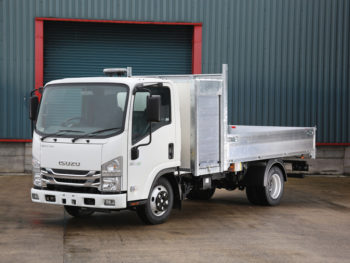Ready-bodied trucks are helping to drive sales success for Isuzu Truck, says Dan Gilkes.

The van and light truck markets continue to grow, seemingly at the expense of the heavier truck sector, as last-mile deliveries and expansion of urban services push demand for vehicles. Much of that growth has been at the all-important 3.5-tonne weight limit, where there is no requirement for additional driving licences, or the complexities of Operator licensing.
The 3.5-tonne sector is shared by both panel vans and chassis cabs, which are then converted into a host of finished vehicles, from tippers and dropsides, to Lutons, box vans and curtain-siders. For van and chassis manufacturers, the need to be able to provide a finished conversion, by working with approved body builders to provide an off-the-shelf range of vehicles, has never been stronger.
If, like Isuzu Truck, there is no panel van on offer, delivering that ready-bodied range – what the company calls a Driveaway product – has become even more important. Indeed, the company recently sold its 1,000th Driveaway vehicle, a 3.5-tonne Grafter dropside, to Melton Mowbray-based Carrier Landscapes.
“Virtually 50% of our sales now are a Driveaway product,” says head of sales Richard Waterworth.
Along with this move to a ready-bodied solution, Isuzu Truck has seen a change of emphasis in the weight of its best-selling trucks. Traditionally, up to 75% of Isuzu’s sales were the 7.5-tonne N75 truck, reflecting the former popularity of the 7.5-tonner in the UK truck market. Though 7.5-tonne sales have fallen overall, the company remains second in the UK 7.5-tonne sector behind market-leader DAF.
“We’re selling more 3.5-tonne trucks now than 7.5-tonners,” says Waterworth. “The game changer has been our latest 3.5-tonne model.”
Isuzu’s current 3.5-tonne truck, the Grafter, was launched in 2017. Introduced to meet Euro 6b standards, the truck featured a downsized 1.9-litre diesel engine, similar to that found in sister company Isuzu’s D-Max pickup. A Euro 6d Temp version will be introduced in the first quarter of 2020. In the truck line the engine delivers 123hp and can be mated to a six-speed manual or six-speed semi-automatic transmission.
The Grafter featured independent front suspension for the first time, greatly improving the ride and drive, while the vehicle’s electrical system went from 24V to 12V as part of a move to a lighter chassis weight. Indeed, that light chassis weight is one of Isuzu’s biggest selling features, with its 3.5-tonne models capable of offering a far higher payload potential than many conventional panel van-based chassis.

The firm’s 3.5-tonne chassis are offered with tipper, dropside and Utilitruk bodies from leading converter TGS (UK). The 3.5-tonne dropside delivers around 1,500kg of payload, with the tipper offering at least 1,200kg. On the heavier 7.5-tonne trucks, there are tipper and dropside conversions from Brit Tipp, along with curtainside and box vehicles on offer from PPS Commercials under the Driveaway banner.
These are by far the most popular conversions, both for Isuzu and in the general market. Indeed, while 30% of all 3.5-tonne chassis cabs are equipped with a dropside body and 28% with a tipper, 57% of Isuzu Grafters are delivered with a tipper and 30% get a dropside body. Though a pre-built design, customers do have an opportunity to tailor the trucks to meet their individual needs. The Driveaway range offers the option of edge protection, Chapter 8 safety livery, flashing beacons, towbars and mesh kits for tipper cages.
“We had a record year in 2018, both in order take and in registrations,” says Waterworth.
“Our dealers really like the Driveaway product, as it provides a single consolidated invoice. The dealers order for stock, to allow customers to almost drive the trucks away once ordered.”
Customers also like the short lead times that Driveaway offers and the fact that the trucks come with a single warranty, with converters offering a three-year unlimited mileage warranty to match that of the chassis. The two companies work closely together to provide a single point of contact for customers, while Isuzu’s dealers now carry faster-moving parts stock for the TGS bodies.
“The partnership that we have with TGS is fantastic. Customer service is key for us and repeat business for us is huge,” says Waterworth.
The company has been making some changes to its network, to further improve service levels. Just this year it has taken on six new dealers for sales and a further three authorised repairers. Some of those changes have been replacement of underperforming outlets, but they have also been about expanding the network. In total the company currently has 40 sales outlets, with 60 service and repair sites.
“There are still a few areas that need looking at for sales outlets,” says Waterworth. “The difference is that people are approaching us now.”
This is perhaps hardly surprising when 67% of the company’s dealers report an increase in sales this year, a number that rises to more than 90% in the North.
“I’m hoping that it will be much the same next year as the last couple of years,” he says.
“We’ve still got a lot more that we can do in the 3.5-tonne market. We’re getting more exposure to customers and the brand is recognised as having Japanese quality and engineering. If the market does drop, I think we’ll buck the trend.”

